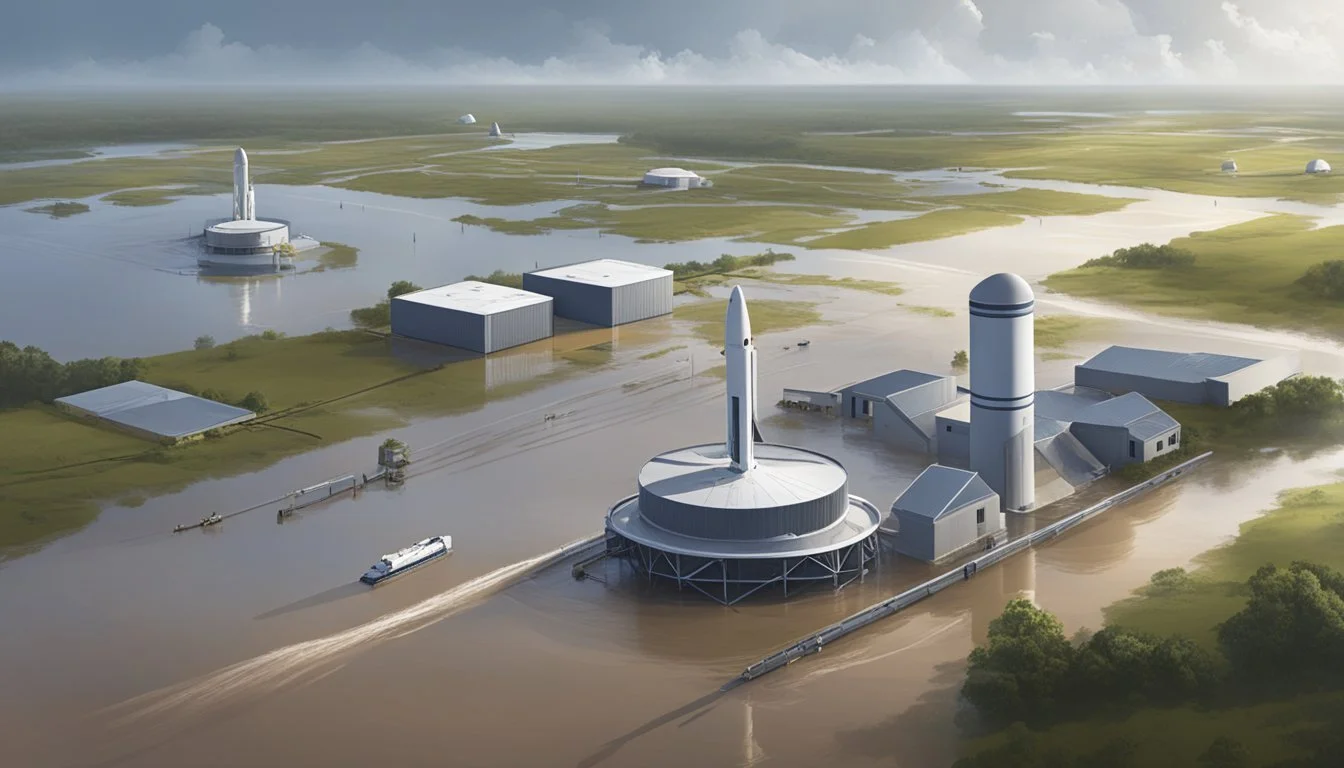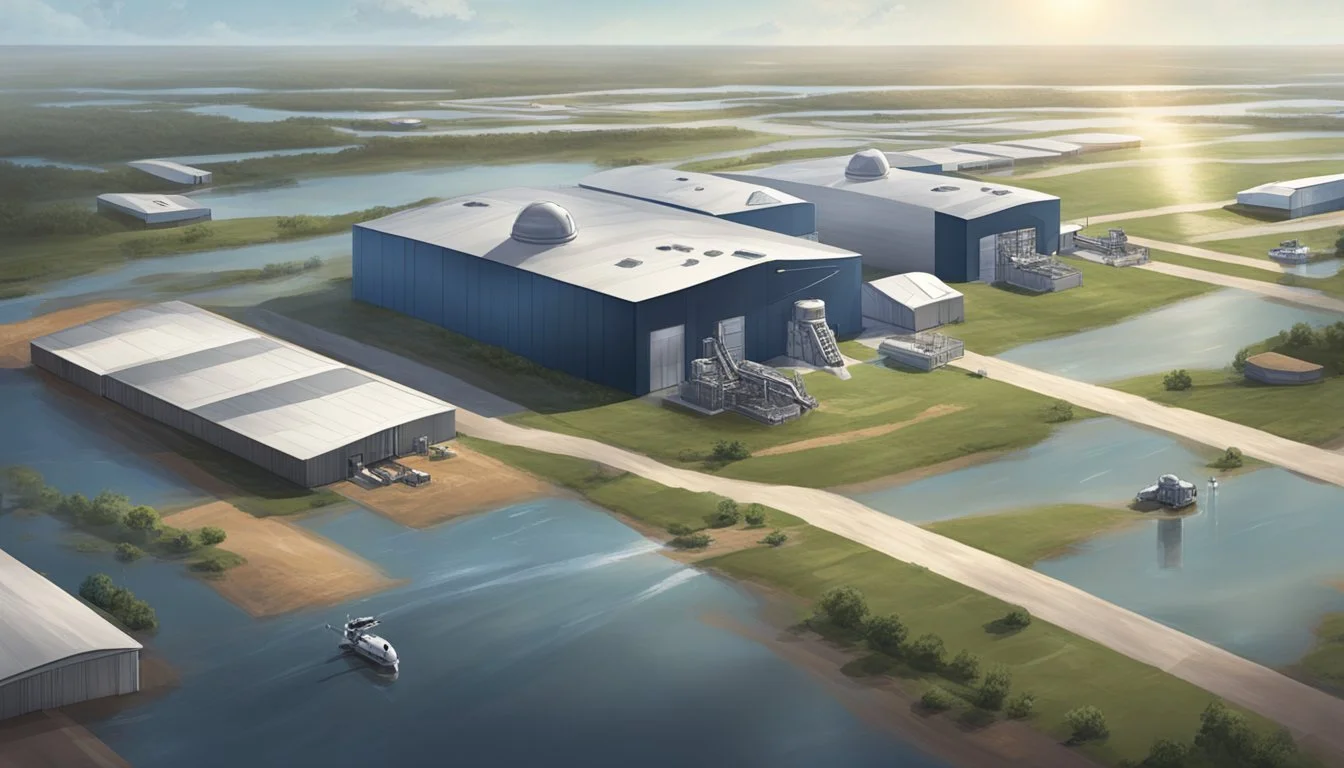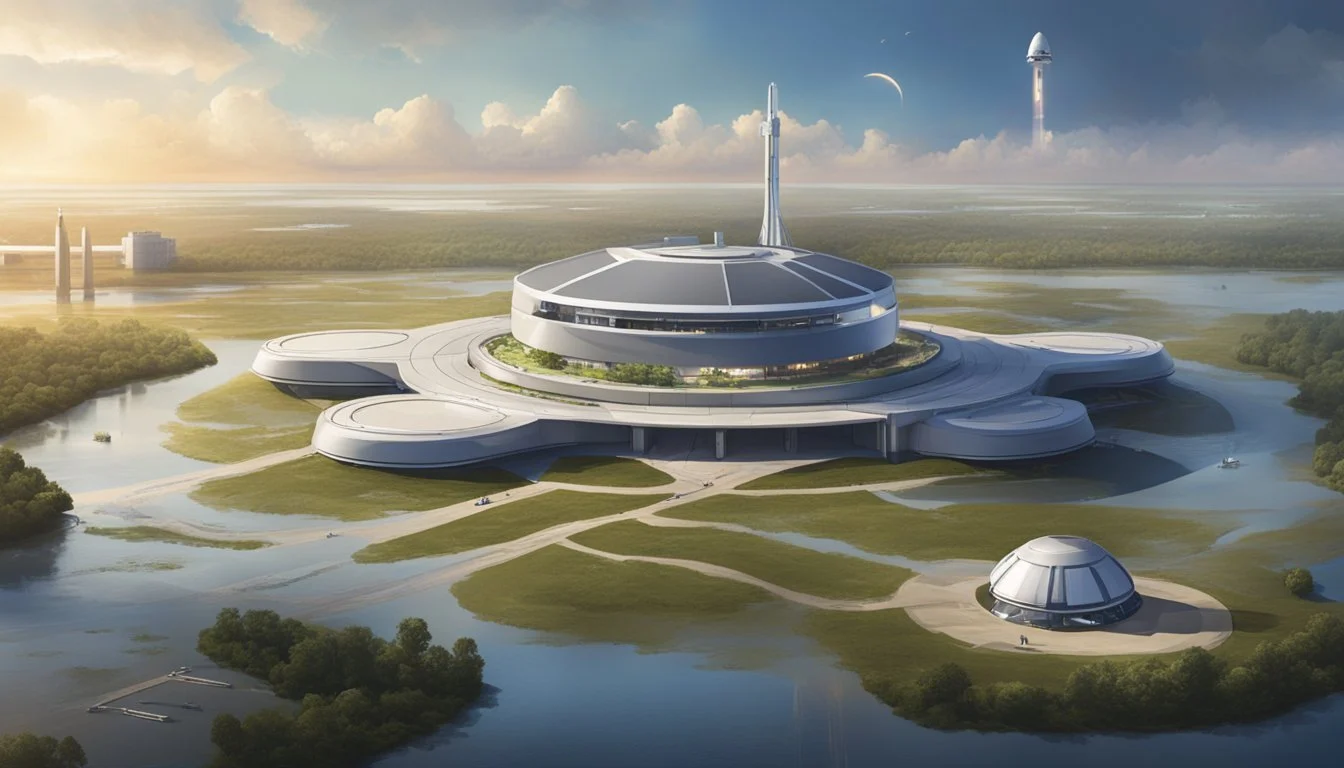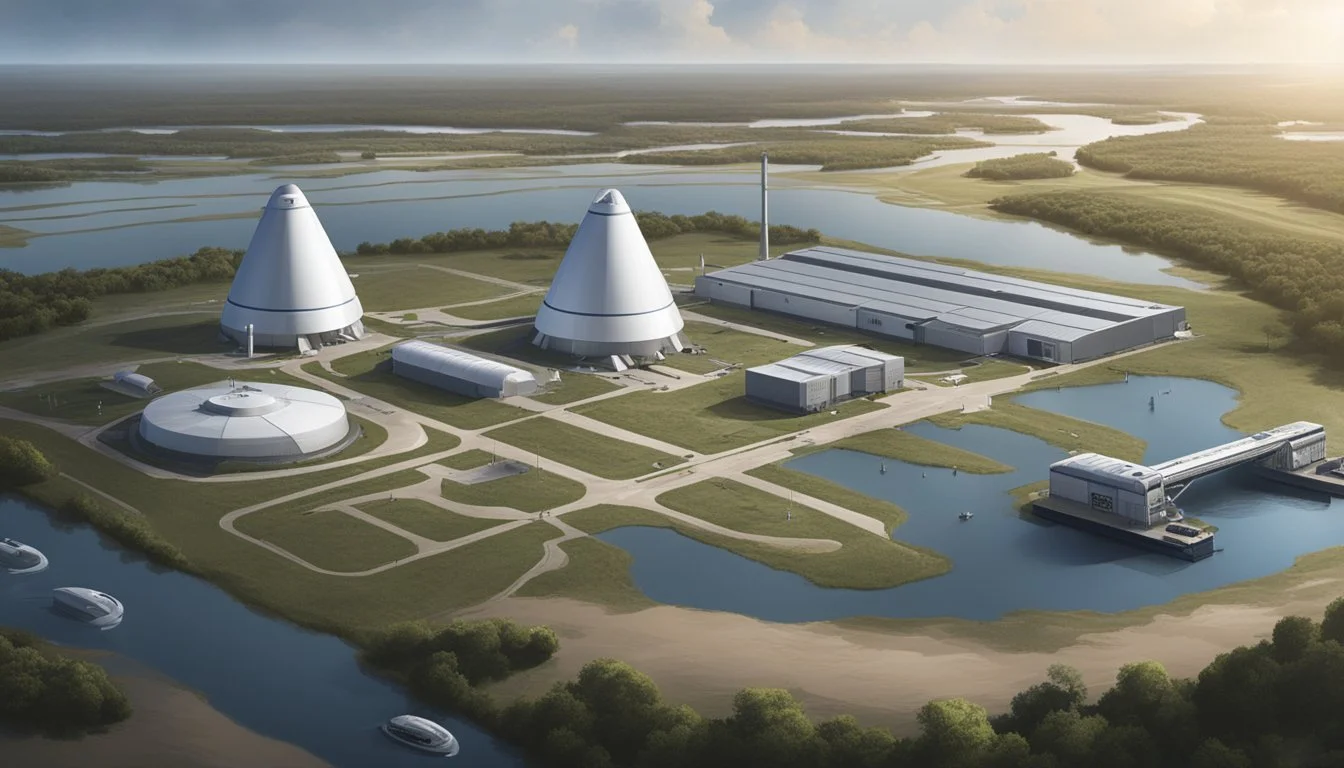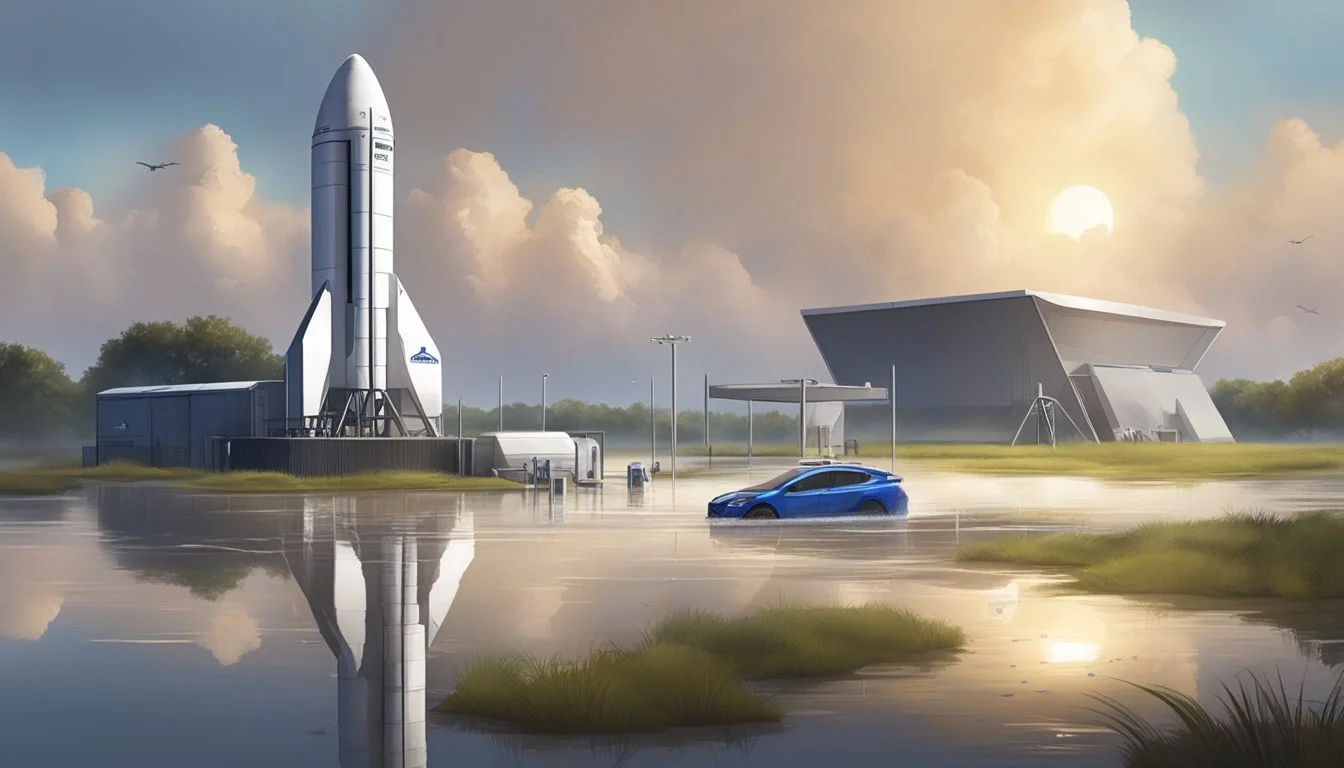SpaceX Starbase Flooding Texas Challenges Launch Operations
Heavy Rains Impact Launch Site Operations
SpaceX's Starbase facility in Texas faces recurring challenges from severe weather events. Recent flooding caused by Tropical Storm Francine has impacted operations at the critical launch site near Brownsville. The storm brought dangerous storm surge and heavy rainfall, leading to inundated roads and potential damage to infrastructure.
This is not the first time Starbase has dealt with flooding issues. Its coastal location makes it vulnerable to hurricanes and tropical storms that frequent the Gulf of Mexico. Climate change projections suggest these risks may intensify in coming decades, potentially threatening the long-term viability of the site.
Despite these challenges, SpaceX continues to use Starbase for testing and launching its next-generation Starship spacecraft. The company has invested heavily in the facility, which plays a crucial role in its ambitious plans for space exploration and satellite deployment. As extreme weather events become more common, SpaceX may need to implement additional protective measures to safeguard its operations and assets at Starbase.
SpaceX and Its Operations at Starbase
SpaceX's Starbase in Texas serves as a crucial hub for the company's ambitious space exploration initiatives. The facility plays a pivotal role in developing and testing the Starship spacecraft, positioning SpaceX at the forefront of commercial spaceflight.
The Strategic Importance of Starbase, Texas
Starbase, located in Boca Chica, Texas, is SpaceX's primary development and testing site for its Starship program. The facility enables rapid prototyping and testing of spacecraft components. Its coastal location provides ideal conditions for launch and recovery operations.
SpaceX has invested heavily in Starbase's infrastructure, including launch pads, production facilities, and support structures. The site's expansion reflects the company's commitment to advancing space technology.
Starbase also serves as a key asset in SpaceX's collaboration with NASA, supporting missions to the Moon and Mars. The facility's capabilities align with NASA's Artemis program objectives, enhancing SpaceX's role in future space exploration endeavors.
Overview of SpaceX's Starship and Super Heavy Rockets
Starship is SpaceX's next-generation spacecraft designed for missions to Earth orbit, the Moon, and Mars. The fully reusable vehicle consists of two stages: Starship (upper stage) and Super Heavy (booster).
Key Starship features:
Height: 50 meters
Payload capacity: Over 100 metric tons
Propulsion: Raptor engines
Super Heavy booster specifications:
Height: 70 meters
Engines: Up to 33 Raptor engines
Thrust: Over 70 meganewtons
SpaceX continues to refine Starship's design through iterative testing at Starbase. The company has achieved significant milestones, including successful high-altitude flights and landing attempts.
Launch Site Selection: Boca Chica and the Gulf Coast Proximity
SpaceX chose Boca Chica for Starbase due to several strategic advantages:
Coastal location: Allows for over-water launches, reducing risks to populated areas
Southern latitude: Provides efficient launches to equatorial orbits
Large, undeveloped area: Enables expansion and ensures safety buffer zones
The site's proximity to the Gulf of Mexico facilitates maritime recovery operations for boosters and spacecraft. This location also minimizes the impact of potential launch failures on populated areas.
Boca Chica's climate offers favorable launch conditions year-round, with exceptions during hurricane season. SpaceX has implemented measures to protect Starbase infrastructure from severe weather events.
Environmental Considerations at the Gulf Coast Location
SpaceX's Starbase facility in South Texas faces unique environmental challenges due to its coastal location. The site's proximity to sensitive ecosystems and strict regulatory oversight requires careful management of operations and potential impacts.
Ecosystems and Wildlife in South Texas
The Starbase facility is situated near wetlands and wildlife refuges along the Texas Gulf Coast. This area is home to diverse plant and animal species, including threatened and endangered species. The region's ecosystems are particularly sensitive to changes in water quality and habitat disruption.
Migratory birds use the coastal areas as stopover points during their annual journeys. Marine life in the Gulf of Mexico could also be affected by activities at the launch site.
Local and Federal Environmental Regulations
SpaceX must comply with both state and federal environmental regulations. The Texas Commission on Environmental Quality (TCEQ) oversees water quality standards and pollution control at the state level.
The Environmental Protection Agency (EPA) enforces federal laws such as the Clean Water Act. These regulations set limits on pollutant discharges and protect water quality.
The Federal Aviation Administration (FAA) also plays a role in environmental oversight, conducting environmental assessments for launch activities.
SpaceX's Environmental Impact and Compliance
SpaceX has faced scrutiny over its environmental practices at Starbase. In 2023, the company was accused of violating the Clean Water Act. Water samples allegedly showed contaminant levels exceeding state standards.
The TCEQ received complaints about SpaceX discharging water from its deluge system. This system is used to suppress fire and sound during rocket launches.
SpaceX stated it is working to obtain an individual permit for its water deluge system. The company must balance its ambitious space exploration goals with responsible environmental stewardship to maintain its operations in this sensitive coastal location.
The Impact of Weather Conditions on SpaceX Operations
SpaceX's Starbase facility in Texas faces significant challenges from severe weather events. Heavy rainfall, storm surges, and hurricanes pose risks to infrastructure and operations. The company has implemented measures to mitigate these impacts.
Challenges of Heavy Rainfall and Storm Surge in Cameron County
Cameron County, where SpaceX's Starbase is located, is prone to flooding from intense storms. Tropical Storm Francine in September 2024 caused significant flooding near the facility. Storm surges can inundate coastal areas, potentially damaging equipment and delaying launches.
Heavy rainfall overwhelms drainage systems, leading to localized flooding. This can disrupt access to the site and affect ground operations. SpaceX must carefully monitor weather forecasts and adjust schedules accordingly.
The Texas Gulf Coast's vulnerability to hurricanes adds another layer of risk. Strong winds and prolonged rain from these systems can force extended shutdowns of Starbase activities.
History of Flooding Events Near Launch Sites
SpaceX has experienced several flooding incidents at Starbase since its establishment. In addition to Tropical Storm Francine, other unnamed storms have impacted the area.
The low-lying coastal location makes Starbase particularly susceptible. Climate projections suggest increased flood risks in the future. By the end of the century, parts of the facility could be underwater due to sea level rise.
SpaceX has learned from each event, adapting its infrastructure and procedures. Elevated platforms for critical equipment and improved drainage systems are among the measures implemented.
SpaceX's Deluge System for Flood Mitigation
SpaceX utilizes a deluge system at Starbase for multiple purposes, including flood mitigation. This system helps manage water during heavy rainfall events.
The deluge system also plays a crucial role in launch operations, suppressing noise and heat during liftoff. However, its use has raised environmental concerns. Reports suggest potential violations of water quality regulations due to pollutant discharge.
SpaceX denies these allegations, emphasizing its commitment to environmental compliance. The company continues to refine its water management practices to balance operational needs with ecological preservation.
Effective flood mitigation is essential for maintaining Starbase's long-term viability in the face of challenging weather conditions.
The Role of SpaceX in Texas' Future Development
SpaceX's presence in South Texas is reshaping the region's economic landscape and infrastructure. The company's activities are generating both opportunities and challenges for local communities.
SpaceX's Economic Influence on South Texas
SpaceX's Starbase facility near Brownsville has become a major economic driver in the area. The company has created hundreds of jobs, attracting skilled workers and boosting local businesses. Hotels, restaurants, and other services have seen increased demand due to SpaceX employees and space enthusiasts visiting the region.
The influx of workers and visitors has led to rising property values in Brownsville and South Padre Island. This economic growth has prompted discussions about diversifying the local economy beyond traditional industries like agriculture and tourism.
Expansion and Infrastructure Developments
SpaceX's operations have spurred infrastructure improvements in South Texas. State Highway 4, the main road to Starbase, has undergone upgrades to accommodate increased traffic. The company has also invested in local utilities and communication networks to support its operations.
Plans for expansion include potential upgrades to nearby ports and airports. These developments could benefit other industries in the region, improving transportation and logistics capabilities for various businesses.
SpaceX's presence has also sparked interest in developing space-related educational programs and research facilities in local institutions.
Existing Challenges and Opportunities for Growth
While SpaceX brings economic benefits, it also presents challenges. Environmental concerns have been raised about the impact of rocket launches on local wildlife and ecosystems. Some residents worry about noise pollution and safety risks associated with launch activities.
The rapid growth has strained local housing markets, making affordability an issue for some long-time residents. This has led to discussions about the need for balanced development strategies.
Opportunities for growth include the potential for space tourism and attracting related industries to the area. Local leaders are working to leverage SpaceX's presence to create a broader aerospace ecosystem in South Texas.
SpaceX and Wastewater Management
SpaceX's Starbase facility in Texas faces challenges with wastewater management and environmental regulations. Rocket launches have raised concerns about water quality and pollution in the surrounding area.
Wastewater Systems at SpaceX Starbase
SpaceX utilizes a deluge system at Starbase to manage the intense heat and energy from Starship launches. This system releases over 400,000 gallons of water during each launch event. The water absorbs heat and suppresses acoustic energy.
SpaceX has implemented water recycling and treatment processes to minimize environmental impact. However, the large volume of water used presents ongoing management challenges.
Environmental Regulations and Wastewater
SpaceX must comply with state and federal regulations for wastewater discharge. The Texas Commission on Environmental Quality (TCEQ) oversees permits and compliance at Starbase.
The facility operates under a Multi-Sector General Permit for stormwater discharges. SpaceX has faced scrutiny over potential Clean Water Act violations related to wastewater management practices.
Regulators have investigated complaints about improper discharge of deluge water into nearby wetlands and waterways.
Impact of Rocket Launches on Water Quality
Rocket launches at Starbase have raised concerns about water pollution in the surrounding ecosystem. Environmental groups have reported elevated levels of contaminants in nearby waters following launch events.
Potential pollutants include fuel residues, heavy metals, and other chemicals associated with rocket propulsion. The deluge water used during launches may carry these contaminants into the environment if not properly managed.
SpaceX continues to work on improving its wastewater treatment and management systems to mitigate these impacts. Ongoing monitoring of water quality in the area aims to assess and address any long-term environmental effects.
Regulatory Compliance and Public Relations
SpaceX faces scrutiny over environmental concerns at its Starbase facility in Boca Chica, Texas. The company's adherence to regulations, community engagement, and transparency are key factors in its ongoing operations.
SpaceX's Adherence to TCEQ and EPA Standards
SpaceX's Starbase facility has come under regulatory scrutiny. The Texas Commission on Environmental Quality (TCEQ) received complaints about water discharge from SpaceX's deluge system in August 2023. TCEQ personnel observed initial tests of the system in July 2023.
SpaceX maintains it is covered by the Texas Multi-Sector General Permit. The company denies violating environmental regulations, contrary to reports citing notices from TCEQ and the Environmental Protection Agency (EPA).
Allegations suggest SpaceX may have violated the Clean Water Act by releasing pollutants into nearby waters. The company faces the challenge of balancing rapid technological advancement with environmental protection standards.
Public Hearings and Community Engagement
SpaceX participates in public hearings related to its Starbase operations. These forums allow local residents to voice concerns and seek information about the facility's environmental impact.
The Federal Aviation Administration (FAA) includes public input in its decision-making process for launch licenses. This engagement helps address flight safety concerns and potential effects on the surrounding area.
SpaceX works to maintain positive relations with the Boca Chica community. The company must navigate the dual goals of advancing spaceflight capabilities and respecting local environmental and quality-of-life issues.
Transparency in Environmental Reporting
SpaceX faces pressure to provide clear, accessible information about its environmental practices. The company's approach to transparency affects public trust and regulatory relationships.
Regular environmental reports help track SpaceX's compliance with TCEQ and EPA standards. These documents detail water quality measurements, air emissions data, and mitigation efforts.
SpaceX uses various channels to communicate its environmental initiatives. This includes official statements, social media updates, and direct community outreach.
The company's transparency efforts are crucial for maintaining its social license to operate in Boca Chica. Open dialogue about environmental concerns helps address public apprehensions about spaceflight activities in the area.
Comparative Analysis of Launch Sites
SpaceX operates multiple launch sites across the United States, each with unique environmental and logistical characteristics. These locations face different challenges and offer varying advantages for space missions.
Boca Chica vs. Kennedy Space Center: Environmental Dynamics
Boca Chica, Texas, home to SpaceX's Starbase, faces coastal erosion and sea-level rise risks. The site's proximity to the Gulf of Mexico exposes it to hurricane threats and potential flooding. Kennedy Space Center (KSC) in Florida shares similar coastal vulnerabilities but benefits from more robust infrastructure and extensive hurricane preparation protocols.
KSC's location on Merritt Island provides some natural barriers against storm surges. Both sites must comply with EPA and state environmental regulations, with KSC having a longer history of environmental management.
Boca Chica's remoteness offers fewer noise concerns for launches, while KSC's operations impact a larger surrounding population.
Gulf Coast Versus Other Regions: Louisiana and Mississippi
Gulf Coast launch sites in Louisiana and Mississippi share similar environmental challenges with Boca Chica. These areas contend with hurricanes, coastal erosion, and wetland preservation issues. Louisiana's Michoud Assembly Facility, while not a launch site, plays a crucial role in rocket production.
Mississippi's Stennis Space Center serves as a rocket testing facility. Both states have established space industry infrastructure but lack the launch capabilities of Texas or Florida sites.
Gulf Coast locations benefit from access to shipping lanes for large rocket components. They also face stricter wetland protection measures compared to inland sites.
SpaceX's Adaptation Strategies at Different Locations
SpaceX tailors its approaches to each launch site's unique challenges. At Boca Chica, the company has implemented erosion control measures and elevated critical infrastructure. The site's design incorporates quick-disconnect systems for rapid equipment removal during storms.
At KSC, SpaceX utilizes existing hurricane-resistant structures and collaborates with NASA on environmental protection efforts. The company has upgraded launch pads to withstand Florida's weather extremes.
For inland sites like Vandenberg Space Force Base in California, SpaceX focuses on fire prevention and seismic considerations. The company's diverse launch site portfolio allows for mission flexibility and risk distribution across different geographical areas.
Conclusion
SpaceX's Starbase facility in Texas faces ongoing challenges from flooding and environmental concerns. Recent storms have highlighted the vulnerability of the coastal site to extreme weather events.
The flooding incidents underscore the need for robust infrastructure and preparedness measures. SpaceX must balance its ambitious space exploration goals with environmental stewardship and regulatory compliance.
Water quality issues near Starbase require careful monitoring and mitigation efforts. The company's responses to environmental notices will be crucial for maintaining positive relations with regulators and local communities.
As climate change potentially increases flood risks, long-term planning for Starbase's sustainability becomes even more critical. SpaceX's ability to adapt its operations and protect the surrounding ecosystem will likely shape the future of this important launch site.
The coming years will reveal how effectively SpaceX can address these challenges while continuing to push the boundaries of space technology at Starbase.

